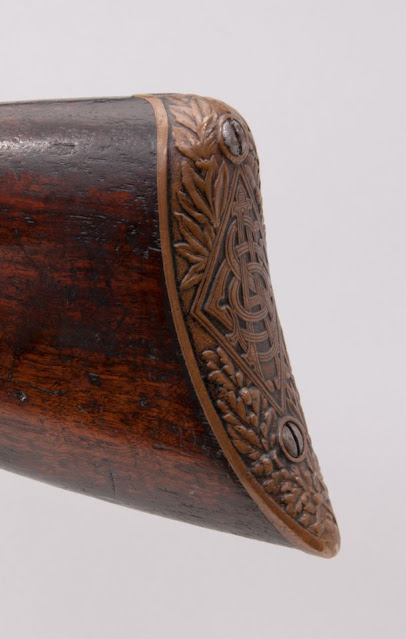This month's featured gun is the Standard Arms Model G
The story of the Standard Arms Model G starts with the man who designed it.
Morris Ford Smith was born on September 29th, 1846 in Philadelphia. Smith was, like many in his day, an inventor. He had at least 13 patents awarded to him at the time of his death, among them firearm designs and inventions for tooling to install rifling on a cannon barrel (retrofitting?).
In his lifetime he had witnessed the change in firearms from muzzle loading to breech loading, from black powder to smokeless powder, from single shot to repeater and from repeater (manual) to fully automatic. It seemed that every change opened doors for more inventions.
If you know the history of the U.S. Military Ordnance Department, you know that they were a finicky bunch and on a near constant search for a better weapon. We can't really blame them, guns were changing at a very rapid rate.
In the span of 30 years the U.S. Military adopted three different rifles (1873, 1894, 1903).
After the turn of the century the Ordnance Department was looking for a possible semi-auto rifle for infantry troops.
Morris Smith was working on designs and had received several patents. Some of these designs went into limited production, but one design, refined over the years, showed promise.
He and Condit had previously created the Smith-Condit Arms Company of Philadelphia (which failed) and they were ready to have another go of it.
They decided to call their new company "Standard Arms". The word standard became much more common in the American lexicon after the start of the Industrial Revolution. A "standard" was the model of product or design on which others would be judged, a perfect example.
As it is with the majority of my featured gun posts, I actually owned one of these rifles for a short time. It was a model G, chambered in .30 Remington (rimless 30-30 Win). The serial number was 5198, I was told this put its manufacture date around 1910, but there is no way to verify that.
On May 16th, 1907 the company was organized in Wilmington, Delaware, they had an investment of $1 Million and had already purchased a factory at 102 F Street in Wilmington (on the corner of F and Spruce streets south of the Christina river). The address on the advert above showed 116 F street, which was probably the company offices. Neither of these addresses exist anymore.
They had plans to hire 150 employees and produce 50 rifles per day. Their goal was to win a lucrative military contract, but also to offer commercial guns for American hunters.
To help promote sales among hunters, the civilian version of their rifles were given a bronze forearm that were cast with wildlife scenes on them
While the guns did not fare well at the 1910 military rifle trials, the company forged ahead and went into production of the commercial guns. The initial offering was a gas operated rifle, that could also be used in manual mode, manual operation was much like a pump action shotgun.
The chamberings were .25, .30 and .35 Remington, which were loaded via the spring loaded floor plate. Chambering a weapon utilized the manual operation and required the depressing of a locking button on the forearm.
Later a manual model, the model M, was added and the gas operated model dropped due to problems with cycling. It seemed to be in the design of a pin in the gas system that was the weak link that often failed.
The company reorganized in 1911, I assume some investors wanted to pull out after the guns failure to perform at the military trials
By 1914 the company was closing up shop. Some 12,000 or so rifles were produced.
Rumor has it that an additional 3500 or so rifles were put together from the parts by the party that purchased what remained of the company. Some say it was a Texas gun shop, others say it was an import/export firm in New York or possibly R.F. Sedgley in Philadelphia. This period of production ended around 1920.
At any rate the guns soon slipped into obscurity, only to surface once in a while due to the attention given to them by blogs like this one.
I have posted links at the bottom if you wish to do some research on your own and let me know if you find anything additional.
As it is with the majority of my featured gun posts, I actually owned one of these rifles for a short time. It was a model G, chambered in .30 Remington (rimless 30-30 Win). The serial number was 5198, I was told this put its manufacture date around 1910, but there is no way to verify that.
Sources:
Williams, David (1907, May 23rd) Iron Age, Vol 79, page 1615
https://www.range365.com/its-pump-its-semiauto-no-its-both/
https://www.forgottenweapons.com/smith-condit-rifle/
Williams, David (1907, May 23rd) Iron Age, Vol 79, page 1615
https://www.range365.com/its-pump-its-semiauto-no-its-both/
https://www.forgottenweapons.com/smith-condit-rifle/
https://dilloncdn.com/bluepress/July_12_savage_1.pdf
https://revivaler.com/standard-arms-model-g-m/
https://www.forgottenweapons.com/standard-arms-model-g-rifles-at-ria-video/
https://gundigest.com/more/classic-guns/remembering-the-late-model-g
http://www.nramuseum.org/guns/the-galleries/modern-firearms-1950-to-present/case-56-hunting-rifles/standard-arms-model-g-autoloader-rifle.aspx
https://revivaler.com/standard-arms-model-g-m/
https://www.forgottenweapons.com/standard-arms-model-g-rifles-at-ria-video/
https://gundigest.com/more/classic-guns/remembering-the-late-model-g
http://www.nramuseum.org/guns/the-galleries/modern-firearms-1950-to-present/case-56-hunting-rifles/standard-arms-model-g-autoloader-rifle.aspx










No comments:
Post a Comment